From May to September, the town is a bustling market place with over a million tourists – from cruise ships – passing through Juneau during the four months, making tourism one of the mainstays of the area’s economy
By Bala Menon
A couple of bald eagles suddenly swoop down, level off and soar away towards the wooded mountains behind a block of red and white painted buildings. The bald eagle has been the national emblem of the United States since 1982 and we are approaching the Alaskan home of this magnificent raptor.
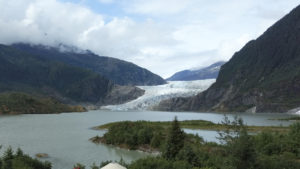
Looking at it from aboard a ship cruising the Inside Passage of the North West Pacific, the city of Juneau – built in the Gastineau Channel and the Alaskan panhandle, does not look anything like a metropolis.
However, Juneau is the capital of the 49th US state of Alaska and the second-largest city (by area) in the United States. Juneau is around 1,356 km from the commercial city of Anchorage. (Alaska itself is the largest of the US states.)

The city downtown is picturesque with beautiful sidewalks and cycle paths bordered with brilliant flowering bushes. Traffic is sparse – and the cycle seems to be the favoured method of transportation. The tallest building is only 11 storeys high.
Towering above the city is Mt. Juneau and other mountains surrounding it include Mt. McGinnis, Mt. Jumbo, Cairn Peak, Gastineau Peak, Mt. Roberts, Thunder Mountain and several rolling, thickly-wooded hills
A cable tramway takes tourists right from the docks half way up on Mount Juneau to an alpine area which has homes with great views, hiking trails, flora and views of Gastineau Channel. This is also the site of the renowned Juneau Raptor Center that looks after lost, infirm and injured eagles and other birds.

The story of Romeo – Juneau’s poster boy – a wild wolf.
From May to September, the town is a bustling market place with over a million tourists – from cruise ships – passing through Juneau during the four months, making tourism one of the mainstays of the city’s economy. Jewellery (gold and precious stones) stores abound, most of them closing after the tourism season, with the operators moving back to sunnier states in the US.
Although an American city, Juneau was established in 1881 by Canadian miner Joseph Juneau (1836–1899) who was born in the Quebec town of Saint-Paul-l’Ermite (later renamed Le Gardeur and then incorporated into Repentigny).
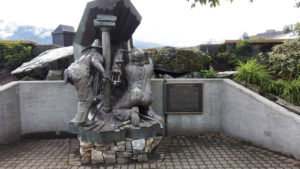
He was one of the early pioneers during the Klondike Gold Rush and it is said that though he struck it reasonably rich, he spent the money as fast as he could. In the end, he opened a small restaurant in Dawson City in the Yukon and died there of pneumonia. Juneau’s cousin Solomon Juneau is credited with founding the city of Milwaukee in Wisconsin.
Juneau today is linked as a sister city to two Canadian cities – Whitehorse, Yukon, and Saskatoon in Saskatchewan.
Juneau became the capital of Alaska in 1906 and is one of most sparsely populated cities in the country – because there is no land access to the city.
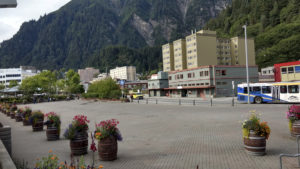
One has to fly in by seaplane or arrive by boat. It is inhabited mostly by state and federal government officials, fishermen and those involved in the logging and tourism industries.
One of the most famous sites in Juneau is the Mendenhall Glacier – located in the Juneau Icefield which has given birth to over 30 glaciers, including the Lemon Creek Glacier visible in the distance from Juneau’s main roads.
We travelled by bus to the glacier about 20 km from Juneau. (There are helicopter rides available for those who want to set foot on the glacier.)
The area is part of the almost 6000 acres of the Mendenhall recreation area, a unit of the heavily wooded federal Tongass National Forest.
The ancient glacier is about 22 km long, travelling from the Juneau Icefield and ending at Mendenhall lake, formed naturally in the late 1920s from its melting ice. Sadly, the glacier is said to be retreating and scientists say its light blue crystal face is shrinking both in height and width, while the lake gets bigger with its new ecosystem boasting an abundance of fish life, including salmon and trout.
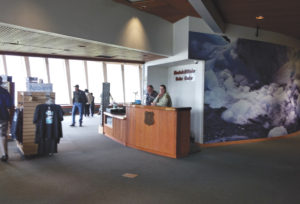
The Mendenhall Glacier Visitor Center perched atop a small hill provides stunning views of the glittering glacier and the surrounding area, bathed as it is in a late August early morning light. Short documentaries about the glacier and its flora and fauna – especially wolves, bears, eagles and mountain goats – are shown in a small cinema at the centre, and there are several interpretative exhibits.
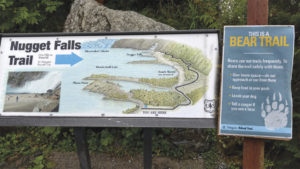
Branching off from the centre are three wonderful trails – Photo Point Trail, the Steep Creek Trail and the popular 1.3 km East Glacier Loop Trail, the last of which leads to the rushing waters of the Nugget Falls right near the face of the Mendenhall Glacier.
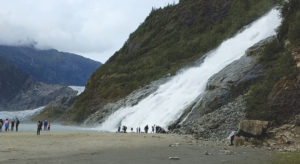
There are signs warning of black bear activity during the summer months, when the animals come out to feed on sockeye salmon on the lakeshore and forest berries in preparation for their winter hibernation.
(We did not, however, see the bears – only their droppings and paw marks in wet muddy areas.) The undergrowth on the lakeshore is also home to beavers, porcupines and the waters have arctic terns and waterfowl.
Nugget Falls is a two-tiered gushing wall of water running off from the Nugget Glacier and dropping about 380 feet over a U-shaped small valley. It falls onto sandbars in the Mendenhall Lake, which feeds the Mendenhall River that empties into the Alaskan Inside Passage.
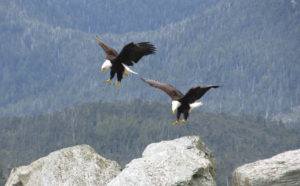
Bald eagles are everywhere in Juneau, You see them perched on every lamppost, every tree stump and every piece of rock that juts out from the Mendenhall River.
Of the estimated 100,000 bald eagles in the world, half of them fly around in Alaska. In Juneau alone, there are around 30,000 bald eagles with wingspans stretching to almost eight feet.
Researchers say these birds of prey can live up to 32 years of age. The bird is, along with the Alaskan wolf, also spiritually important for the territory’s First Nations people.
Pictures by Bala Menon













Leave a Reply